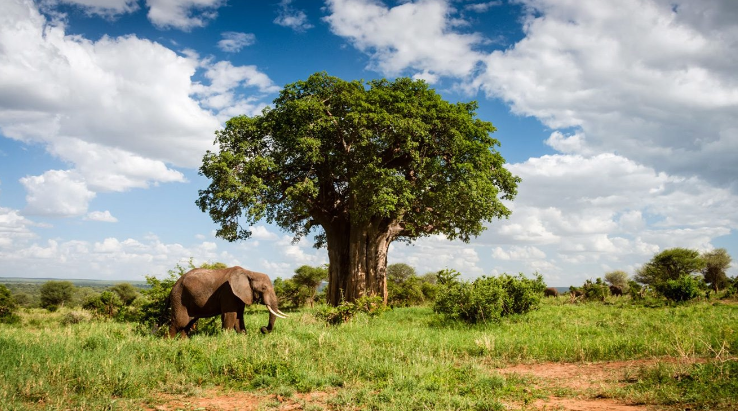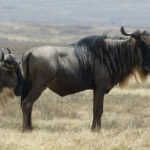With one of the largest elephant populations in Tanzania, Tarangire National Park is a spectacle for anyone fascinated by the marvels of nature. These gentle giants roam freely among the park’s iconic, ancient baobab trees, some of which are centuries old. It’s a sight that captivates both laymen and seasoned experts alike.
Established in 1970, Tarangire National Park spans over 2,850 square kilometers, making it a vital sanctuary for wildlife conservation. In addition to its renowned elephants, the park boasts over 550 bird species, making it a paradise for ornithologists. Such biodiversity underscores Tarangire’s critical role in both ecological preservation and scientific study.

Exploring the Ecosystems of Tarangire National Park
Tarangire National Park is renowned for its diverse ecosystems that create a haven for wildlife. The park features a mix of river valleys, wetlands, and savannas, each supporting unique flora and fauna. The winding Tarangire River is a lifeline for animals, especially during the dry season. Its banks are often crowded with zebras, wildebeests, and buffaloes. This variety of habitats makes the park a biodiversity hotspot.
The flora within the park is dominated by ancient baobabs, which can reach impressive heights and diameters. These trees are not only majestic but also serve as vital resources for wildlife. Many animals feed on their fruits, while some birds nest in their branches. The park also boasts numerous acacia woodlands and grassy plains. Together, these plant communities support a complex web of life.
Wildlife enthusiasts will be thrilled by the wide array of species found here. Beyond the famous elephants, the park is home to lions, leopards, and cheetahs. Bird watchers can spot over 550 species, including the colorful yellow-collared lovebird. The park’s varied habitats ensure a steady supply of food and shelter for these creatures. Each visit offers a new chance to witness nature’s drama unfold.
Efforts to preserve this rich biodiversity have been significant. Conservation programs focus on protecting endangered species and maintaining natural habitats. Anti-poaching patrols and community education are key components. These initiatives help ensure the park remains a sanctuary for future generations. The park’s success in wildlife conservation serves as a model for other reserves.
The Diversity of Flora: Dominance of Giant Baobabs
Giant baobabs are one of the most striking features of Tarangire National Park. These ancient trees can live for over a thousand years and grow up to 30 meters tall. Their massive trunks can store thousands of liters of water, which helps them survive in arid conditions. During the dry season, their bare, twisted branches create a dramatic silhouette against the sky. They are sometimes called the “upside-down trees” because their leafless branches look like roots.
Aside from baobabs, the park is home to a variety of other tree species. Acacia trees are particularly common, adding to the park’s unique landscape. These trees provide shelter and food for many animals, including giraffes and elephants. The different types of trees create diverse habitats within the park. This variety supports a wide range of wildlife.
The plant life in Tarangire is not just limited to trees. There are also numerous grasses, shrubs, and flowering plants. During the rainy season, the park transforms into a green oasis with vibrant wildflowers. These plants attract insects, which in turn support bird and mammal populations. The seasonal changes in vegetation are crucial for maintaining the park’s ecological balance.
Baobabs, along with other flora, play vital roles in the ecosystem. They help prevent soil erosion and retain water, which supports other plants and animals. These trees also provide crucial nesting sites for birds and habitats for insects. Conservation efforts aim to protect these remarkable trees and the diverse plant life they support. By preserving the flora, we help ensure the health of the entire ecosystem.
The Fauna Highlights: Focus on the Elephant Population
Tarangire National Park is renowned for its large elephant herds. These majestic animals are a key attraction for visitors. During the dry season, they gather near the Tarangire River to drink and bathe. This river serves as a vital water source for the elephants and many other species. Observing these herds in their natural habitat is a breathtaking experience.
The elephants in Tarangire play a crucial role in the ecosystem. Their movements help to shape the landscape by trampling paths and spreading seeds. This activity promotes growth of new vegetation, supporting a healthy environment. Additionally, the elephants help create waterholes, which are essential for other animals. Their presence ensures a dynamic and thriving habitat.
Beyond elephants, the park is home to a diverse range of wildlife. This includes lions, leopards, and various antelope species. Bird watchers will be thrilled by the park’s vibrant avian population. With over 550 species, there’s always something new to discover. These animals rely on the resources provided by the elephants’ landscape modifications.
Conservation efforts in the park focus on protecting these magnificent creatures. Anti-poaching measures are strictly enforced to safeguard the elephants. Community education programs are also essential in promoting coexistence. These initiatives ensure that elephants can roam freely and safely. The park’s dedication to conservation sets an example for wildlife protection worldwide.
Conservation Efforts in Tarangire National Park
Conservation efforts in Tarangire National Park are vital for protecting its rich biodiversity. These initiatives aim to safeguard the habitats of various species, from the giant baobabs to the elephants. Anti-poaching patrols are a critical part of this strategy. Rangers work tirelessly to prevent illegal hunting and protect wildlife. Their presence has significantly reduced poaching incidents.
Community involvement is another cornerstone of conservation. Local communities are educated about the importance of preserving the park’s ecosystem. Programs encourage sustainable practices and provide alternative livelihoods. These efforts help foster a sense of ownership and responsibility. When communities see the benefits, they become active participants in conservation.
Several organizations collaborate to support these conservation efforts. Partnerships between government agencies, NGOs, and international bodies are crucial. These collaborations bring in resources and expertise needed for effective conservation. They also help monitor the health of the park’s ecosystems. Data collected from these initiatives guide future strategies and improvements.
One innovative approach is the development of eco-tourism. Tourists visiting the park contribute to conservation through entrance fees and direct donations. Eco-friendly lodges and campsites are designed to minimize environmental impact. Visitors are educated about the park’s flora and fauna, fostering greater appreciation and awareness. This sustainable tourism model ensures that conservation efforts are funded and supported.
Research and monitoring are also essential components of conservation. Scientists study the behavior and population dynamics of key species. This research helps in making informed decisions about managing the park. Tracking systems and camera traps provide valuable data on wildlife movement. Such technologies enhance the effectiveness of conservation strategies.
The Impact of Tourism on Tarangire National Park
Tourism plays a significant role in Tarangire National Park, benefiting the local economy and conservation efforts. Visitor fees generate crucial funding for park maintenance and wildlife protection. These revenues help support anti-poaching measures and habitat restoration projects. Additionally, tourism creates job opportunities for local communities. This, in turn, encourages sustainable practices and environmental stewardship.
Tourism also enhances awareness and appreciation of Africa’s natural heritage. Visitors learn about the park’s unique ecosystems and the importance of conservation. Guided tours offer educational experiences that leave lasting impressions. Many tourists become advocates for wildlife protection after their visit. The park’s rich biodiversity and spectacular landscapes provide endless opportunities for learning.
However, tourism can also have negative impacts if not managed responsibly. High numbers of visitors can lead to habitat degradation and disturbances to wildlife. Off-road driving, for example, can damage vegetation and soil structures. Littering poses another threat to the park’s pristine environment. To mitigate these risks, the park enforces strict guidelines for visitors.
Efforts to promote sustainable tourism are essential for balancing benefits and impacts. Eco-friendly accommodations and low-impact activities are encouraged. The park has implemented measures to control visitor numbers and minimize their footprint. These initiatives ensure that tourism remains a positive force. Sustainable tourism helps protect the park for future generations.
Community involvement is key to successful sustainable tourism. Local residents participate in tourism planning and operations. They benefit economically from tourism while helping to protect natural resources. This collaborative approach fosters a sense of ownership and responsibility. When communities are involved, tourism becomes a powerful tool for conservation.
Key Takeaways
- Tarangire National Park is famous for giant baobab trees.
- The park has a significant elephant population.
- It spans 2,850 square kilometers in Tanzania.
- Diverse ecosystems attract many wildlife species.
- The Tarangire River is vital during the dry season.















